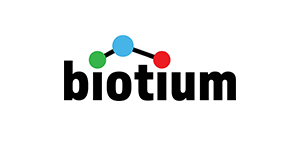Apoptotic, Necrotic & Healthy Cells Quantitation Kit Plus (50 assays)
Apoptotic, Necrotic & Healthy Cells Quantitation Kit Plus (50 assays)
SKU
BTM30066
Packaging Unit
50 Assays
Manufacturer
Biotium
Availability:
loading...
Price is loading...
Description: The Apoptosis, Necrosis & Healthy Cells Quantitation Kit Plus provides a convenient assay for quantifying apoptotic (green), necrotic (red), and total (blue) cells within the same cell population by flow cytometry or fluorescence microscopy. Apoptosis and necrosis are two major processes by which cells die. Apoptosis is an active, genetically regulated disassembly of the cell from within. During apoptosis, phosphatidylserine (PS) is translocated from the inner to the outer leaflet of the plasma membrane for phagocytic cell recognition. The human anticoagulant Annexin V is a 35 kDa, Ca2 -dependent phospholipid-binding protein with high affinity for PS. Annexin V labeled with CF®488A (Abs/Em: 490/515 nm) stains apoptotic cells green by binding to PS exposed on the cell surface. CF®488A is spectrally similar to fluorescein (FITC), with much brighter and more photostable fluorescence. Necrosis normally results from severe cellular insult. Both internal organelle and plasma membrane integrity are lost, resulting in the release of cellular contents into the surrounding environment. Ethidium homodimer III (EthD-III) is a highly positively charged nucleic acid probe, which is impermeant to live cells, but stains cells with compromised membrane integrity with red fluorescence (Abs/Em (with DNA): 528/617 nm). EthD-III is a superior alternative to propidium iodide (PI) or ethidium homodimer I because of its significantly higher affinity for DNA and higher fluorescence quantum yield. The kit also includes the membrane permeable DNA dye Hoechst 33342 (Abs/Em (with DNA) 350/461 nm) to stain all cell nuclei blue.
Product Origin: Animal, Synthetic - BSA from bovine serum (cow; Bos taurus), Annexin V (recombinant produced in E. coli)
Kit Components:
- CF®488A-Annexin V
- Ethidium homodimer III
- Hoechst 33342
- 5X binding buffer
Features:
- Simple: Simultaneous detection of apoptotic, necrotic, and total cells in a single assay
- Fast: A single 15-30 min staining step
- Sensitive: CF®488A-Annexin V is brighter and more photostable than FITC-Annexin V, while EthD-III is a superior alternative to both PI and EthD-I for staining necrotic cells.
Product Origin: Animal, Synthetic - BSA from bovine serum (cow; Bos taurus), Annexin V (recombinant produced in E. coli)

 Deutsch
Deutsch






